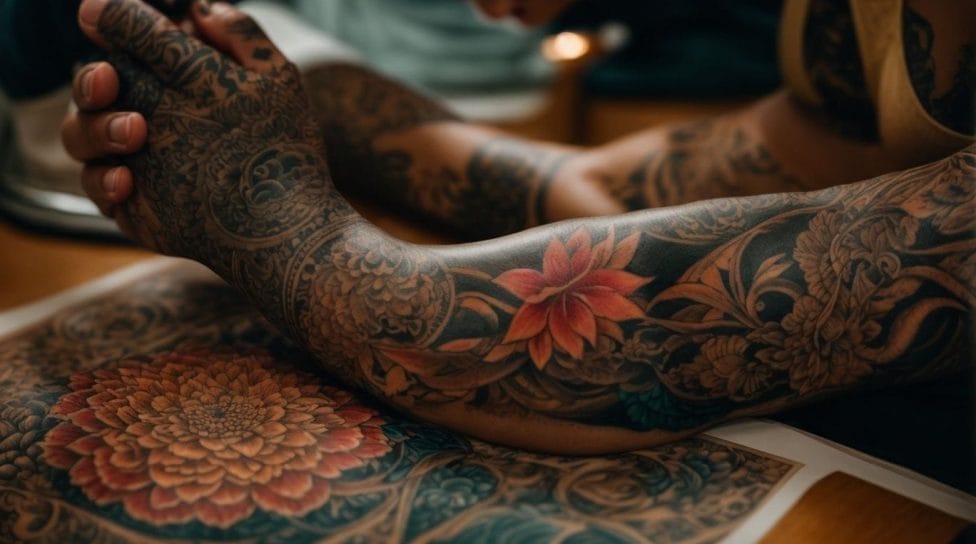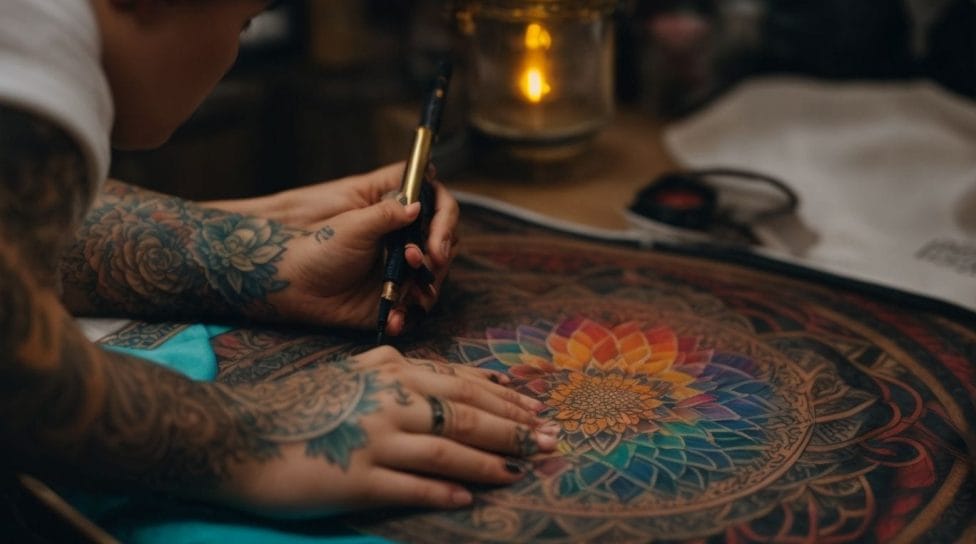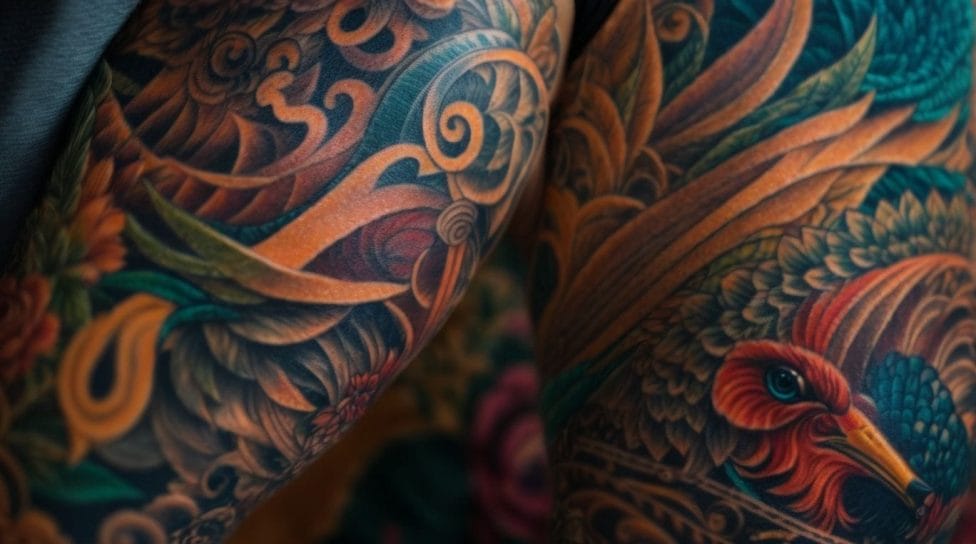Getting a tattoo is a significant decision, and one of the common questions people have is how long the tattooing process takes. Several factors influence the time it takes to complete a tattoo, and understanding these factors can help you plan accordingly for your tattoo session. Here are some key factors that influence tattooing time:
1. Tattoo Size: The tattoo’s size determines how long it will take. Smaller tattoos can be completed relatively quickly, while larger tattoos require more time and multiple sessions.
2. Tattoo Design Complexity: Intricate and detailed designs take longer to tattoo than simple designs. The complexity, shading, and color work involved can significantly impact the time required.
3. Tattoo Placement: The tattoo’s placement on your body can affect the time it takes to complete. Areas with more curves, bony prominences, or sensitive skin may require more time and precision from the tattoo artist.
4. Artist Skill and Speed: The skill and speed of the tattoo artist also affect the overall time. Experienced artists with efficient techniques may complete tattoos faster compared to those who are less experienced.
For small tattoos, the estimated completion time can vary depending on the design and intricacy. Tips for faster healing can help ensure proper aftercare and promote optimal healing.
For medium-sized tattoos, the estimated completion time may be longer than for smaller tattoos due to the increased size and complexity. Proper aftercare practices are essential for optimal healing and to maintain the tattoo’s longevity.
Large tattoos require more time as they often involve intricate details, shading, and color work. An artist may recommend multiple sessions to complete a large tattoo, each allowing for proper healing before proceeding with additional work.
Full sleeve or extensive tattoos are a significant commitment and can take a considerable amount of time to complete. The estimated completion time for a full-sleeved tattoo depends on the design, size, and intricacy. A staged approach, planning sessions strategically, can help achieve the desired result.
Remember, each tattoo is unique, and the time required to complete it will vary. It is essential to consult with your tattoo artist, discuss your design, and understand the estimated completion time based on your specific requirements.
Key takeaway:
- Tattooing time varies depending on size, design complexity, placement, artist skill, and speed.
- Small tattoos generally take less time to complete and heal faster, while larger tattoos may require multiple sessions and longer healing stages.
- Full sleeve or extensive tattoos can take a significant amount of time to complete and may require careful planning and a staged approach.
Factors That Influence Tattooing Time

Photo Credits: Tattooineplanet.Com by Peter Jones
Getting a tattoo is an exciting step, but have you ever wondered how long it takes? Today, we’ll uncover the factors that can influence tattooing time. From the size of the tattoo to the complexity of the design and even the placement on your body, each aspect plays a role in the duration of the tattooing process. And let’s not forget the skill and speed of the tattoo artist. So, let’s dive in and explore what determines how long your tattoo session will last!
Tattoo Size
The size of a tattoo, whether small, medium, or large, plays a significant role in the time it takes to complete and heal.
- Small Tattoos: Small tattoos, such as a simple symbol or letter, can be completed quickly, usually within 30 minutes to an hour.
- Medium Tattoos: A medium-sized tattoo, like a small design or a word, may take a few hours to complete, depending on the intricacy.
- Large Tattoos: Large tattoos, such as a detailed portrait or intricate sleeve, can take multiple sessions and several hours to finish, often spanning several weeks or months.
- Pro-tip: Remember, regardless of the tattoo size, proper aftercare is crucial for optimal healing and preservation of your tattoo.
Tattoo Design Complexity
The complexity of a tattoo design plays a crucial role in determining the time it takes to complete the tattoo. Different factors can contribute to the complexity, including the level of detail, intricate patterns, shading, and color variation involved in the design.
To illustrate this information in a table:
| Tattoo Design Complexity | Factors |
|---|---|
| High Complexity |
|
| Medium Complexity |
|
| Low Complexity |
|
Suggestions for choosing a tattoo design complexity:
- Consider your pain tolerance, as more complex designs may require longer tattoo sessions.
- Consult with a skilled artist who can guide how the complexity of a design can impact the final result.
- Choose a design that aligns with your style and preferences while also considering the amount of time you are willing to invest in the tattooing process.
Tattoo Placement
When considering tattoo placement, it’s important to consider factors such as visibility, pain tolerance, and future career prospects. Tattoo placement is a crucial aspect to consider when deciding to get inked. Different areas of the body have different levels of pain and healing time, so choose a placement that aligns with your pain threshold and lifestyle. For example, when deciding on tattoo placement, it’s essential to consider that tattoos on the hands, face, or neck may be more visible and potentially affect job opportunities. On the other hand, when thinking about tattoo placement, areas like the arms, legs, or back offer more flexibility and easier concealment. Ultimately, the choice of tattoo placement is a personal decision that should be carefully considered.
Artist Skill and Speed
An artist’s skill and speed are vital factors in tattooing. Consider these essential points about an artist’s skill and speed:
- Experience: It is crucial to select an artist with a substantial tattooing experience. Over time, they will have perfected their skills and become more adept at executing intricate designs.
- Precision: A skilled artist possesses a steady hand and exceptional attention to detail. This ensures that the tattoo lines are precise and clean, resulting in a high-quality tattoo.
- Efficiency: Speed holds importance, particularly for larger tattoos. A skilled artist can work efficiently without compromising the tattoo’s quality, allowing quicker completion without rushing the process.
- Portfolio: Look at the artist’s previous work to evaluate their skill and style. This will provide insight into their expertise and determine if their artistic abilities align with your desired tattoo.
By considering an artist’s skill and speed, you can choose a tattoo artist who will not only create a beautiful design but also complete it efficiently and to your satisfaction.
Small Tattoos

Photo Credits: Tattooineplanet.Com by Bryan Moore
Discover the world of small tattoos and all that it entails. From the estimated time for a small tattoo completion to tips for faster healing, we’ll delve into the fascinating realm of these inked masterpieces. Uncover the secrets behind the artistry and dedication of creating these timeless symbols. So, if you’re thinking of getting a small tattoo or are intrigued by this form of self-expression, join us as we journey into the captivating world of small tattoos.
Estimated Time for Small Tattoo Completion
- The estimated time for small tattoo completion can vary depending on several factors.
- The estimated time for small tattoo completion can vary depending on several factors.
- Tattoo size: Smaller tattoos generally take less time to complete compared to larger ones.
- Tattoo design complexity: Intricate designs with fine details may require more time and precision.
- Tattoo placement: The location of the tattoo on the body may impact the time needed for completion.
- Artist skill and speed: The expertise and efficiency of the tattoo artist can influence the completion time.
- On average, a small tattoo can take 15 minutes to 1 hour to complete. It’s essential to communicate with your tattoo artist to get a more accurate estimate based on the specific design and your individual preferences.
Tips for Faster Healing
To promote faster healing after getting a tattoo, consider implementing these essential tips for faster healing:
| Follow the aftercare instructions provided by the tattoo artist, including regularly washing and moisturizing the tattooed area. |
| Avoid picking or scratching at the tattoo to prevent infections and speed up the healing process. |
| Protect the tattoo from direct sunlight or tanning beds to prevent fading and damage to the healing skin. |
| Stay hydrated and maintain a balanced diet to support overall skin health and enhance the healing process. |
| Ensure the tattooed area remains clean and dry, avoiding excessive moisture or damp environments. |
By following these tips, you can facilitate faster healing and ensure the longevity of your tattoo.
Medium Tattoos

Photo Credits: Tattooineplanet.Com by David Flores
Are you looking to get a medium-sized tattoo? Let’s dive into the fascinating world of medium tattoos and discover the estimated time it takes to complete these designs, as well as some helpful tips for optimal healing. From discussing the artistic process to understanding the factors that influence the duration, we’ll uncover everything you need about medium tattoos. So, if you’re ready to embark on your tattoo journey, join us as we explore the ins and outs of these captivating creations.
Estimated Time for Medium Tattoo Completion
- The estimated time for completing a medium-sized tattoo, also known as the “Medium Tattoo Completion Time,” can vary depending on several factors.
- These factors include the complexity of the design, the placement of the tattoo, and the skill and speed of the artist.
- When estimating the completion time for a medium tattoo, it is important to consider the following:
- Tattoo Size: Larger medium tattoos may take longer to complete than smaller ones.
- Tattoo Design Complexity: Intricate designs with lots of details may require more time and precision.
- Tattoo Placement: Certain body areas may be more challenging to tattoo and require additional time.
- Artist Skill and Speed: Experienced artists may be able to complete a medium tattoo more efficiently.
- To get a more accurate estimation of the time required for your specific medium-sized tattoo, it is important to consult with your tattoo artist.
Tips for Optimal Healing
For optimal healing, here are some tips to ensure the longevity and appearance of your tattoo:
| – Follow the aftercare instructions provided by your tattoo artist. |
| – Keep the tattoo clean and moisturized using a gentle, fragrance-free lotion. |
| – To prevent infection, avoid picking or scratching the tattoo. |
| – Do not expose the tattoo to excessive sunlight or soak it in water for extended periods. |
| – Wear loose clothing to prevent rubbing and irritation. |
| – During the healing process, avoid strenuous activities and sweating. |
| – Promote healing by staying hydrated and maintaining a healthy diet. |
| – Until it’s fully healed, avoid submerging the tattoo in pools, hot tubs, or ocean water. |
| – If you notice any infection or complications, visit your tattoo artist. |
Follow these tips for optimal healing and take care of your tattoo effectively.
Large Tattoos

Photo Credits: Tattooineplanet.Com by Mark Lopez
Large tattoos are a bold statement, but have you ever wondered how long they take to complete? In this section, we’ll uncover the estimated time for large tattoo completion, including the intriguing details of multiple sessions and the various stages of healing. Get ready to dive into the fascinating world of large tattoos as we explore the time-consuming yet rewarding process behind these intricate works of art.
Estimated Time for Large Tattoo Completion
The estimated time for the completion of a large tattoo depends on various factors, including the complexity of the design, the placement on the body, and the skill and speed of the artist. On average, it can take several hours to finish a large tattoo, sometimes requiring multiple sessions spanning several weeks or even months. It is crucial to acknowledge that the healing process plays a significant role in getting a tattoo and can impact the overall time needed for its completion. To ensure a timely finish, it is essential to provide proper care and follow the aftercare instructions, as this can help expedite the healing process and contribute to the timely completion of your large tattoo.
Multiple Sessions and Healing Stages
- When getting extensive tattoos, it is common to have multiple sessions and healing stages.
- First, consult with your artist to discuss your design ideas and the size of the tattoo.
- Next, determine the number of sessions needed to complete the tattoo during the planning stage.
- In the first session, your artist will do the initial outline or shading of the tattoo.
- After the first session, it is important to allow the tattoo to heal fully before scheduling the next session.
- In the subsequent sessions, your artist will add details and colors to the tattoo.
- During the healing stages, follow proper aftercare instructions to ensure the tattoo heals well.
- Finally, the tattoo will be reviewed, and any necessary touch-ups will be done as part of the final touches.
By breaking the tattoo into multiple sessions and allowing for proper healing stages, you can achieve the desired result without compromising the quality of the tattoo.
Full Sleeve or Extensive Tattoos

Photo Credits: Tattooineplanet.Com by Timothy Green
Are you planning to get a full-sleeve tattoo? Wondering how long it will take to complete this extensive artwork? In this section, we’ll dive into the estimated time for full sleeve tattoo completion and explore the planning and staged approach involved. Whether considering an intricate design or showcasing multiple themes, we have the insights to help you manage your expectations and make informed decisions. Let’s unravel the fascinating process of bringing your full-sleeve tattoo vision to life!
Estimated Time for Full Sleeve Tattoo Completion
The completion time for a full-sleeve tattoo can vary depending on several factors. Here is a list of steps that may impact the overall time it takes to finish a tattoo:
- Design Consultation: Collaborate with the tattoo artist to create a custom design.
- Multiple Sessions: Full-sleeve tattoos are typically done in multiple sessions to allow for healing and prevent artist fatigue. The number of sessions depends on the complexity and size of the design.
- Healing Stages: Each session requires a healing period, usually a few weeks before additional work can be done.
- Coloring and Shading: Full-sleeve tattoos often involve intricate coloring and shading, which can extend the completion time.
- Artist Availability: The availability of the tattoo artist may affect the scheduling of sessions and, consequently, the overall time it takes to complete the tattoo.
Historically, full-sleeve tattoos have been an integral part of various cultures, such as the Japanese tradition of full-body tattoos known as Irezumi. These tattoos often required multiple sessions and were regarded as a lifelong commitment, representing status and identity within the community.
Planning and Staged Approach
Planning and a staged approach are essential when getting a large tattoo or a full sleeve. Here are some steps to consider:
- Consultation: Schedule a consultation with your tattoo artist to discuss your ideas, size, and placement.
- Design and Placement: Work with your tattoo artist to create a design that fits your vision and suits the placement area.
- Outline: The first stage involves outlining the design, which provides a framework for the tattoo.
- Shading and Color: Once the outline is complete, the shading and color work can begin, adding depth and detail to the tattoo.
- Healing and Aftercare: Proper aftercare is crucial for a successful outcome. Follow your tattoo artist’s instructions to ensure proper healing and minimize complications.
- Additional Sessions: Depending on the complexity and size of the tattoo, multiple sessions may be needed to complete the artwork.
Taking a planned and staged approach ensures that your tattoo is executed precisely and allows for optimal healing and satisfaction with the final result.
Some Facts About How Long Do Tattoos Take:
- ✅ There is no set time limit for getting a tattoo. (Source: Our Team)
- ✅ The time it takes to complete a tattoo depends on complexity, size, and location. (Source: Our Team)
- ✅ Small tattoos usually take around an hour to complete. (Source: Our Team)
- ✅ Large back pieces can take between seven to ten hours to complete. (Source: Our Team)
- ✅ Color tattoos generally take longer to complete than black and gray tattoos. (Source: Our Team)


